As I've discussed in a number of past news writeups, Microsoft has now broadened its vision for the Kinect 3-D camera (and microphone array) system beyond its Xbox 360 game console origins to also encompass computer interfaces, thereby formalizing a relationship that existed from Kinect's earliest days courtesy of the hacker community. PC-optimized hardware began shipping in March, for example, accompanied by a "gold'" release of the SDK for Windows 7 and 8; the latter has received ongoing regular enhancement since then, most recently a month ago.
In a Microsoft blog post published just last week, Chris White (Kinect for Windows' Senior Program Manager) described further SDK enhancements to come, in the area of 3-D modeling. Here are some excerpts from the writeup:
Kinect Fusion was first developed as a research project at the Microsoft Research lab in Cambridge, U.K…Kinect Fusion reconstructs a 3-D model of an object or environment by combining a continuous stream of data from the Kinect for Windows sensor. It allows you to capture information about the object or environment being scanned that isn’t viewable from any one perspective. This can be accomplished either by moving the sensor around an object or environment or by moving the object being scanned in front of the sensor.
The tool averages the readings over hundreds or thousands of frames to achieve more detail than would be possible from just one reading…Among other things, it enables 3-D object model reconstruction, 3-D augmented reality, and 3-D measurements. You can imagine the multitude of business scenarios where these would be useful, including 3-D printing, industrial design, body scanning, augmented reality, and gaming.
For more information, see the following additional-coverage links:
More recently, today in fact, Microsoft researchers Dan Liebling and Meredith Ringel Morris are presenting "Kinected Browser: Depth Camera Interaction for the Web" at the ACM's 2012 ACM Conference on Interactive Tabletops and Surfaces. As longstanding (and highly technical) Microsoft observer Long Cheng notes in an iStartedSomething blog post, Kinected Browser is "a toolkit which enables web developers to detect Kinect gestures and speech using a simple JavaScript library." Here's more from Cheng:
With the introduction of Kinect for Windows earlier this year and the increasing adoption of HTML5 and CSS3 browsers which support rich multi-touch events, Dan and Meredith saw an opportunity to expand the developer reach of the Kinect SDK beyond its C# and C++ roots. The team recognizes some existing work by the community of Kinect and browser integrations: Swimbrowser, an app that uses Kinect to “swim” around websites but does not offer any developer endpoints, and DepthJS, a Safari and Chrome plugin that exposes a similar JavaScript library with more focus on high-level gestures.
In contrast to these, Kinected Browser is a low-level approach that only exposes raw sensor (RGB and depth) data. It works by two components, a browser plugin that talks directly Kinect C++ SDK and a JavaScript library which a web developer can include and redistribute on the page. In the future, the browser plugin can also be abstracted to work with a number of depth camera systems. The benefits of this “versatile” approach is that they support many more exciting scenarios such as a “Web applications using depth data, e.g., to scan physical artifacts and input them into 3D printing services” or even multi-user interactions on a single website enabled by facial recognition and skeleton tracking.
Liebling and Morris's paper is currently published on the Microsoft Research project page, and the downloadable Kinected Browser library is scheduled to also appear there later today.


